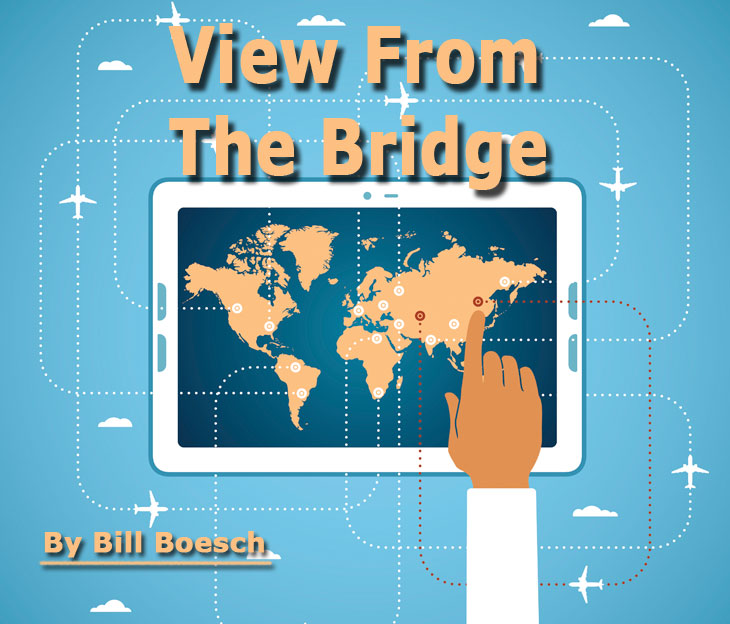
 As
2016 begins we welcome to our editorial staff Bill Boesch,
who will bring regular contributions of thought and
insight. As
2016 begins we welcome to our editorial staff Bill Boesch,
who will bring regular contributions of thought and
insight.
As top executive at Pan
Am, American Airlines, and DHL for the past half century,
Bill has been an outspoken proponent of air cargo and
also a dreamer and doer in our industry—a leader
of the form.
Here he shares his unique
insight and outlook for 2016 and beyond.
We welcome your comments
and ideas. You can write to Bill at bill@aircargonews.com.
I
am a firm believer that air transportation is needed,
but I also think that the level or type of aircraft
utilized to carry freight and potential return in terms
of market share and additional factors—including
in price and time requirements—needs to be analyzed
to gain proper perspective when forming a correct overview
of air cargo in 2016.
First up as we begin
2016 and this series of articles, let’s consider
air cargo transported on passenger airlines.
Later we will examine
the integrators, then scheduled all cargo service, followed
by non-scheduled freighter service, and finally by other
lower-priced options to fixed wing air cargo service.
But first things first,
we must look at the massive fleets fielded worldwide
by the carriers, all or most of which carry air cargo.
In the airline business,
you can add a lot of enhancements to the passenger product.
But in the end that is
what the classes of service should differentiate and
each class of service has to compete on price and quality.
This is true for most
industries selling products to consumers, including
air cargo.
On the passenger side
the industry continually enhanced its products’
quality and appeal based on passenger feedback and that
process appears to be needed today with the customer
feedback statistics we are seeing.
Even with all the improvements
over the years, there are times in this airline industry
where profits are meager at best.
Bob Crandall, a great
airline leader I had the honor to work with, had a sign
on his desk I often quote. It read, “If God had
meant people to fly he would have made it profitable.”
You might say the same
thing at times about air cargo.
Some passenger airlines
do not fly freighters because they didn’t make
a profit on their own.
You can say the same
for some passenger routes, but they are operated because
those routes supported the profit of the whole and were
not looked at as standalone, and I believe that in some
cases, depending on the size and routes of the airline,
freighters within a passenger airline need to be viewed
the same way.
They should be carefully
controlled as a support to maximize the profitability
of cargo in the bellies of the passenger aircraft and
not as a standalone operation.
Now, I’m not saying
that I believe in a large freighter fleet within a passenger
airline, because I don’t.
Over 90 percent of air
cargo can easily fit in large, wide-body passenger aircraft
bellies and therefore have costs much lower than the
cargo that moves on freighters. And, moving cargo to
maximize your passenger aircraft’s unused belly
capacity is extremely profitable for the airline. In
addition, cargo moving in large aircraft bellies have
more flights and times to destination and if handled
correctly can give the customer a better service quality
than an all-cargo operation and can therefore have the
potential to charge a higher price.
So why is it in a passenger
airline’s interest to operate a few freighters?
Because some cargo, due
to its size, cannot fit into a wide-body belly compartment
and needs to move on a freighter. You might say, “so
what!” But because passenger airlines—unlike
FedEx, UPS, etc.—primarily get their cargo through
airfreight forwarders rather than directly from the
shipper, the airfreight forwarders use this lack of
freighters as a negotiating tool to lower the price
of the passenger carriers who do not operate them. Therefore
the industry needs a paradigm shift, which I'm the first
to say can be dangerous and costly.
However, the timing is
right.
To do this, airlines
need to develop top cargo expert leaders to run their
cargo departments just like they have on their passenger
side, and they need to let them run and fund their cargo
business under a P&L that holds the cargo department
accountable to maximize the use of the belly capacity.
Carriers need quality
measurement IT systems that measure quality from their
customers’ view point, state of the art scheduling
and booking systems, revenue management systems, and
top management control systems.
Airlines need systems
with artificial intelligence tied to their passenger
systems that learn as they operate, and these systems
require large investments
With fuel prices predicted
to continue dropping to (perhaps) $20 a barrel, I believe
the large passenger airline that invests in an operation
similar to the above will significantly increase its
overall profits and return to its shareholders.
Bill Boesch |



